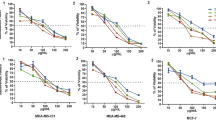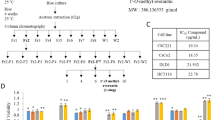Abstract
Cancer remains one of the leading causes of death worldwide, particularly pancreatic cancer being lethal because of its aggressiveness and lack of early detection methods. A factor that contributes to malignancy are cancer stem cell-like characteristics promoted by the tumor–stromal interaction. Given that fibroblast conditioned medium (CM) promotes sphere formation of cancer cells, a cancer stem cell-like characteristic, its inhibitor could be a new anticancer agent. By exploring microbial cultures as a source, we found new compounds, namely, adenopeptins B (1) and C (2), from Acremonium sp. ESF00140. 1 and 2 selectively and potently inhibited the sphere formation of pancreatic cancer cells cultured in the fibroblast CM compared with the control medium. Oxygen consumption rate (OCR) assays showed that 1 and 2 inhibit OCR in pancreatic cancer cells. Studies of similar compounds suggested mitochondrial complex V inhibition. Therefore, results of measuring the activity of human mitochondrial complex V revealed that 1 and 2 inhibited its activity. Oligomycin A, an inhibitor of mitochondrial complex V, as well as 1 and 2, strongly inhibited the sphere formation of pancreatic cancer cells cultured in fibroblast CM. The addition of 1 and 2 to pancreatic cancer cells cultured in fibroblast CM increased reactive oxygen species (ROS) production compared with that in the control medium. In pancreatic cancer cells cultured in fibroblast CM, mitochondria significantly influence sphere formation, and targeting their function with 1 and 2 might provide a new therapeutic approach for pancreatic cancer.
This is a preview of subscription content, access via your institution
Access options
Subscribe to this journal
Receive 12 print issues and online access
$259.00 per year
only $21.58 per issue
Buy this article
- Purchase on Springer Link
- Instant access to full article PDF
Prices may be subject to local taxes which are calculated during checkout




Similar content being viewed by others
References
Mizrahi JD, Surana R, Valle JW, Shroff RT. Pancreatic cancer. Lancet. 2020;395:2008–20.
Siegel RL, Miller KD, Jemal A. Cancer statistics, 2019. CA Cancer J Clin. 2019;69:7–34.
Rossi F, Noren H, Jove R, Beljanski V, Grinnemo KH. Differences and similarities between cancer and somatic stem cells: therapeutic implications. Stem Cell Res Ther. 2020;11:489.
Dean M, Fojo T, Bates S. Tumour stem cells and drug resistance. Nat Rev Cancer. 2005;5:275–84.
Eyler CE, Rich JN. Survival of the fittest: cancer stem cells in therapeutic resistance and angiogenesis. J Clin Oncol. 2008;26:2839–45.
Jena BC, Das CK, Bharadwaj D, Mandal M. Cancer associated fibroblast mediated chemoresistance: a paradigm shift in understanding the mechanism of tumor progression. Biochim Biophys Acta Rev Cancer. 2020;1874:188416.
Boesch M, et al. Heterogeneity of cancer stem cells: rationale for targeting the stem cell niche. Bba-Rev Cancer. 2016;1866:276–89.
Nair N, et al. A cancer stem cell model as the point of origin of cancerassociated fibroblasts in tumor microenvironment. Sci Rep. 2017;7:6838.
Tatsuda D, Yoshida J, Ohishi T, Kawada M. Pancreatic stromal cell-derived Oncostatin M confers drug resistance to a multi-tyrosine kinase inhibitor in pancreatic cancer cells. Anticancer Res. 2023;43:2477–89.
Shintani Y, et al. Pulmonary fibroblasts induce epithelial mesenchymal transition and some characteristics of stem cells in non-small cell lung cancer. Ann Thorac Surg. 2013;96:425–33.
Tatsuda D, et al. Coccoquinones A and B, new anthraquinone derivatives produced by Staphylotrichum coccosporum PF1460. J Antibiot. 2016;69:176–8.
Kawada M, Inoue H, Usami I, Ikeda D. Phthoxazolin A inhibits prostate cancer growth by modulating tumor-stromal cell interactions. Cancer Sci. 2009;100:150–7.
Yoshida J, et al. Mitochondrial complex I inhibitors suppress tumor growth through concomitant acidification of the intra- and extracellular environment. iScience. 2021;24:103497.
Hayakawa Y, Adachi M, Kim JW, Shin-Ya K, Seto H. Adenopeptin, a new apoptosis inducer in transformed cells from Chrysosporium sp. Tetrahedron. 1998;54:15871–8.
Iijima M, et al. Acremopeptin, a new peptaibol from Acremonium sp PF1450. J Antibiot. 2017;70:791–4.
Walcher L, et al. Cancer stem cells-origins and biomarkers: Perspectives for targeted personalized therapies. Front Immunol. 2020;11:1280.
Hayakawa Y, et al. Efrapeptin J, a new down-regulator of the molecular chaperone GRP78 from a marine Tolypocladium sp. J Antibiot. 2008;61:365–71.
Momose I, et al. Mitochondrial inhibitors show preferential cytotoxicity to human pancreatic cancer PANC-1 cells under glucose-deprived conditions. Biochem Bioph Res Commun. 2010;392:460–6.
Papathanassiu AE, MacDonald NJ, Emlet DR, Vu HA. Antitumor activity of efrapeptins, alone or in combination with 2-deoxyglucose, in breast cancer in vitro and in vivo. Cell Stress Chaperon. 2011;16:181–93.
Kitamura K, Itoh H, Sakurai K, Dan S, Inoue M. Target identification of Yaku’amide B and its two distinct activities against mitochondrial FoF1-ATP synthase. J Am Chem Soc. 2018;140:12189–99.
Shchepina LA, et al. Oligomycin, inhibitor of the F-0 part of H+-ATP-synthase, suppresses the TNF-induced apoptosis. Oncogene. 2002;21:8149–57.
Vaamonde-Garcia C, et al. Oligomycin, an inhibitor of complex V of the mitochondrial respiratory chain, induces an inflammatory and oxidative response in rat knee joint. Osteoarthr Cartilage. 2014;22:S293–4.
Ikeda H, Kawami M, Imoto M, Kakeya H. Identification of the polyether ionophore lenoremycin through a new screening strategy for targeting cancer stem cells. J Antibiot. 2022;75:671–8.
Tucker JM, Townsend DM. Alpha-tocopherol: roles in prevention and therapy of human disease. Biomed Pharmacother. 2005;59:380–7.
Kang KS, et al. Docosahexaenoic acid induces apoptosis in MCF-7 cells in vitro and in vivo via reactive oxygen species formation and caspase 8 activation. PLoS ONE. 2010;5:e10296.
Xue D, Zhou X, Qiu J. Emerging role of NRF2 in ROS-mediated tumor chemoresistance. Biomed Pharmacother. 2020;131:110676.
Murphy MP. How mitochondria produce reactive oxygen species. Biochem J. 2009;417:1–13.
Sancho P, et al. MYC/PGC-1alpha balance determines the metabolic phenotype and plasticity of pancreatic cancer stem cells. Cell Metab. 2015;22:590–605.
Kowaltowski AJ, de Souza-Pinto NC, Castilho RF, Vercesi AE. Mitochondria and reactive oxygen species. Free Radic Biol Med. 2009;47:333–43.
Lamb R, et al. Antibiotics that target mitochondria effectively eradicate cancer stem cells, across multiple tumor types: treating cancer like an infectious disease. Oncotarget. 2015;6:4569–84.
Acknowledgements
We thank Ms. Yumiko Kubota, Dr. Shinya Adachi, and Dr. Kiyoko Iijima for the measurements of NMR and MS spectrum. We also thank Ms. Tamami Yoshida, Ms. Satomi Unno, and Ms. Rina Ando for their technical assistance. We thank the Support group for Molecular Profiling of Advanced Animal Model Support by a Grant-in-Aid for Scientific Research on Innovative Areas, Scientific Support Programs for Cancer Research, from The Ministry of Education, Culture, Sports, Science and Technology, Japan, for providing us with the SCADS inhibitor kits.
Author information
Authors and Affiliations
Corresponding author
Ethics declarations
Conflict of interest
The authors declare no competing interests.
Additional information
Publisher’s note Springer Nature remains neutral with regard to jurisdictional claims in published maps and institutional affiliations.
Supplementary information
Rights and permissions
Springer Nature or its licensor (e.g. a society or other partner) holds exclusive rights to this article under a publishing agreement with the author(s) or other rightsholder(s); author self-archiving of the accepted manuscript version of this article is solely governed by the terms of such publishing agreement and applicable law.
About this article
Cite this article
Tatsuda, D., Amemiya, M., Nosaka, C. et al. Two new adenopeptins B and C inhibit sphere formation of pancreatic cancer cells. J Antibiot 77, 73–84 (2024). https://doi.org/10.1038/s41429-023-00679-y
Received:
Revised:
Accepted:
Published:
Issue Date:
DOI: https://doi.org/10.1038/s41429-023-00679-y
This article is cited by
-
A new linear peptide, higapeptin, isolated from the mud flat-derived fungus Acremonium persicinum inhibits mitochondrial energy metabolism
Journal of Natural Medicines (2024)



